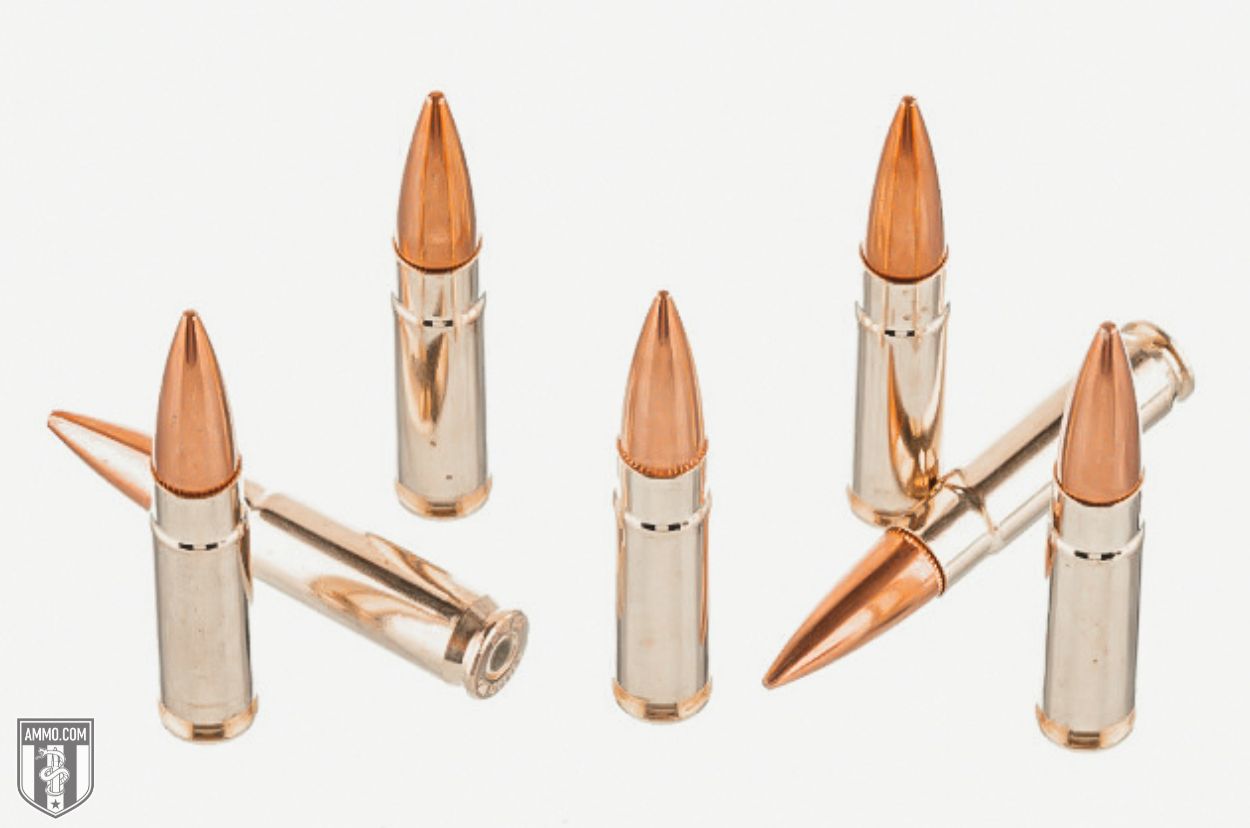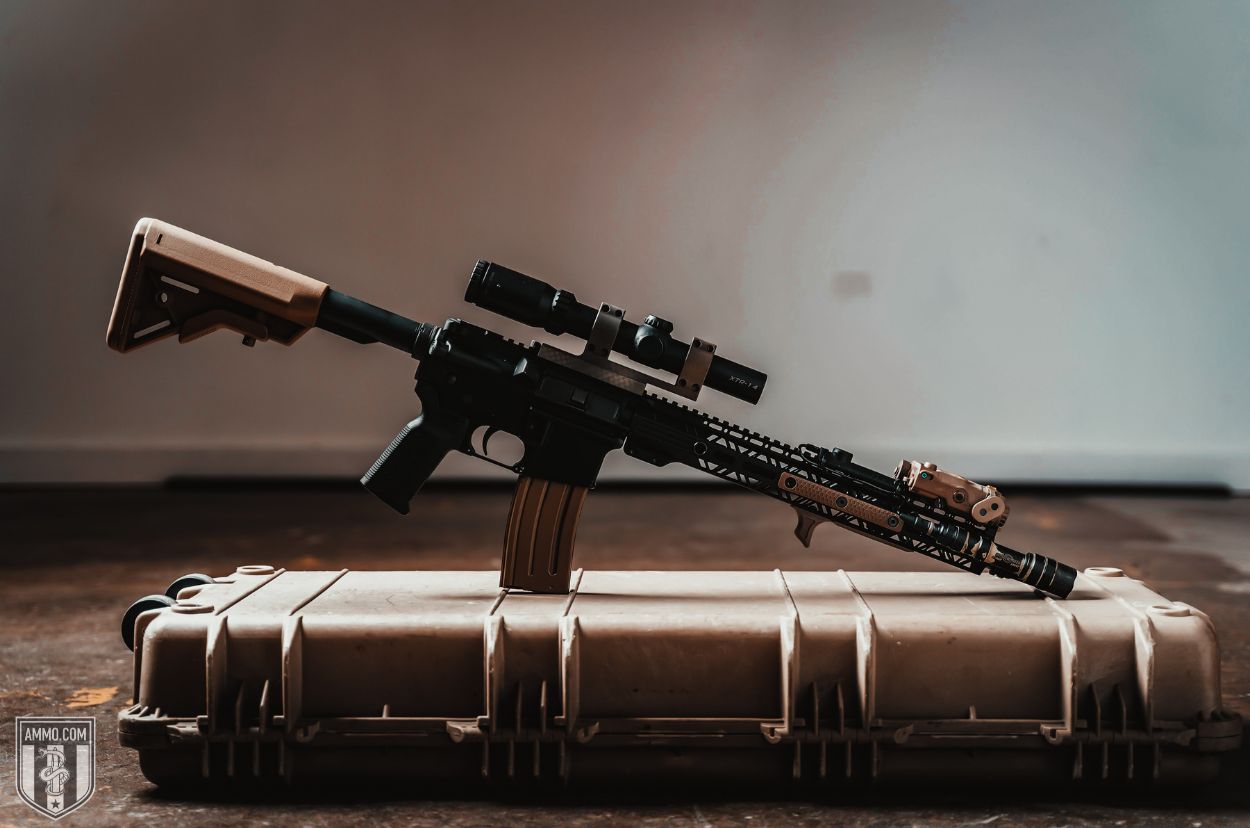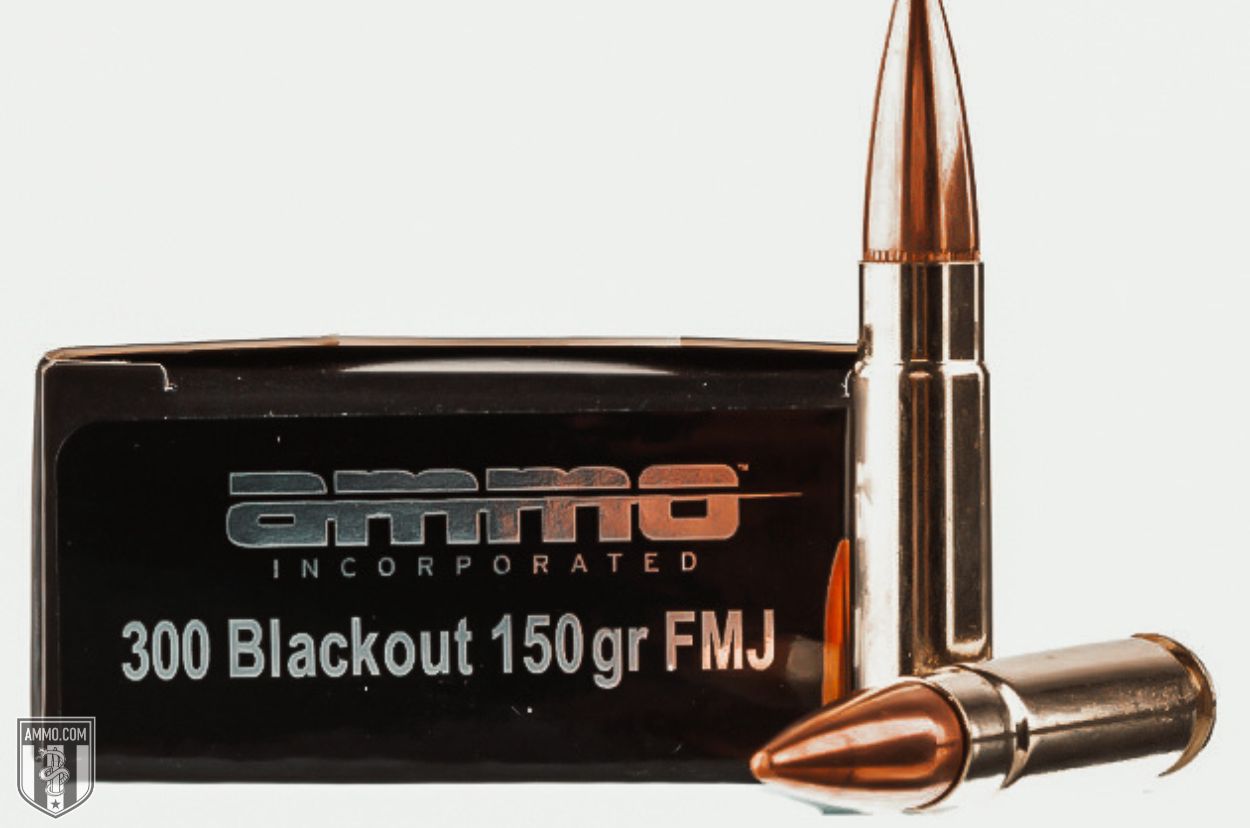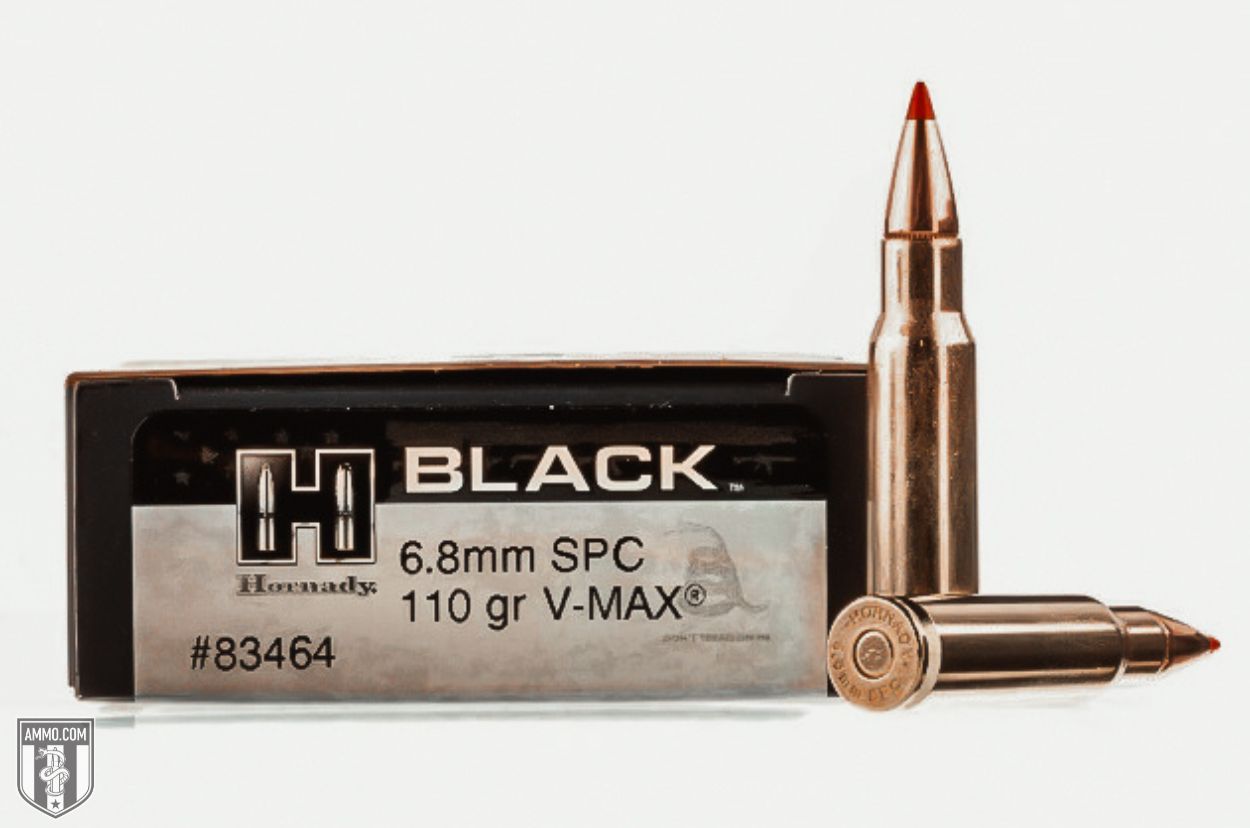6.8 SPC vs 300 Blackout: Powering Up the AR Platform
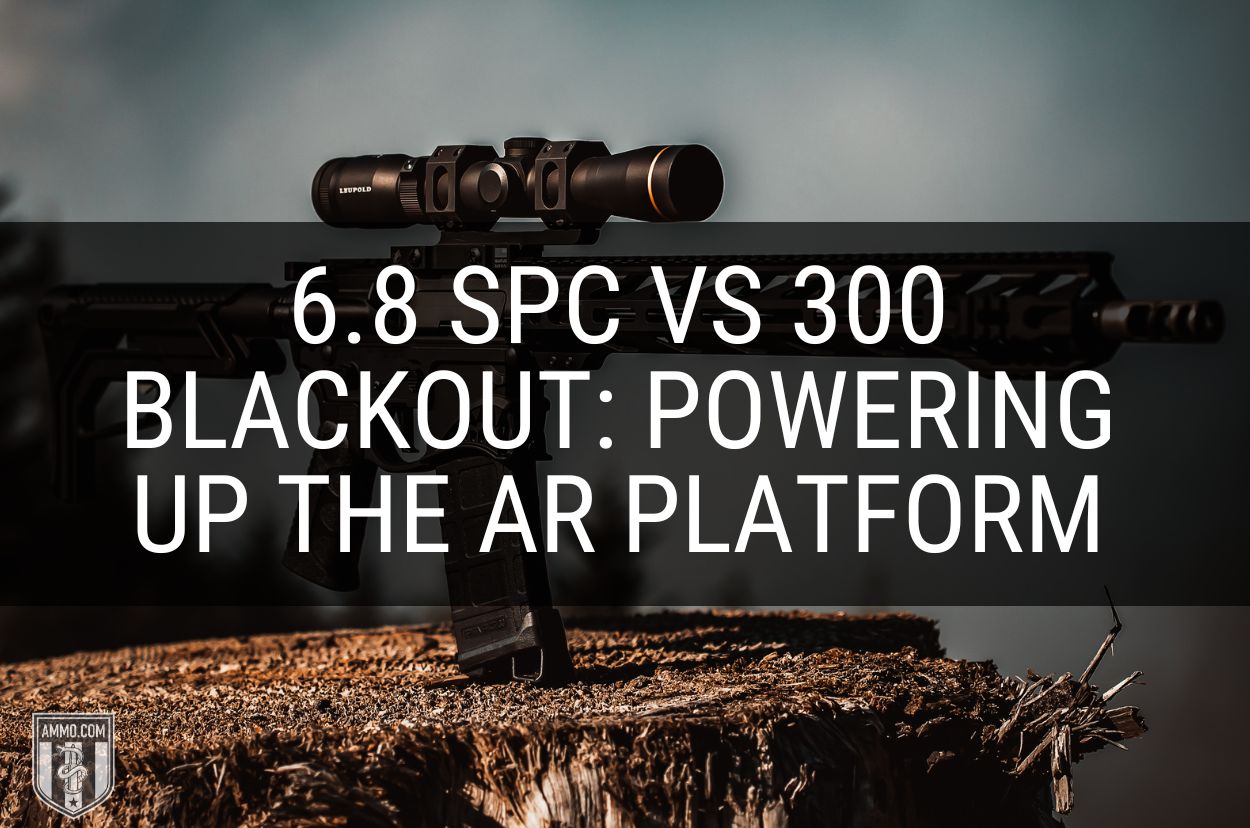
If you want to increase the stopping power of your standard AR-15 chambered in 5.56 NATO, then the 300 Blackout and 6.8 SPC are excellent options.
Both rifle cartridges offer improved terminal ballistics over the 5.56 and function well for home defense, hunting, and general target shooting.
Whether you’re looking to invest in a dedicated rifle or simply swap upper receivers, deciding which caliber to choose can be daunting.
In this article, I will give you the straight facts about these two calibers and help you decide which of these two rifle cartridges is the best choice for your next AR-15.
What’s the Difference Between 6.8 SPC and 300 Blackout?
The most significant difference between the 6.8 SPC and 300 Blackout is the caliber bullet each round fires. The 300 Blackout is designed to fire the classic 30-caliber 0.308” diameter bullet, while the 6.8 SPC fires a 0.277” diameter bullet. Furthermore, the 300 Blackout will typically fire heavier bullets than the 6.8 SPC.
Cartridge Specs
When evaluating centerfire cartridges, it’s a good idea to analyze the cartridge specs to gain more knowledge of each.
Perhaps the most striking difference between these two cartridges is the caliber bullet each fires. The 300 AAC Blackout fires the iconic American 30-caliber bullet, 0.308” diameter like a 308 Win, while the 6.8 SPC fires a 0.277” diameter bullet like a 270 Winchester.
Although both cartridges fire a different diameter bullet, they were both developed using 30-caliber cartridges. The 300 Blackout hails its lineage from the 300 Whisper, while the 6.8 SPC was birthed from the classic 30 Remington case.
Both rounds have the same overall length of 2.26” as they are intermediate cartridges designed to fit into a standard AR-15 action.
However, when you look at these cartridges side-by-side, you can clearly see that the 6.8 SPC is wider with a 0.422” base diameter compared to 0.367” for the 300 Blackout. This striking design difference is one of the major differences between the two cartridges, as 300 Blackout is designed to fit in standard 5.56 mags while the 6.8 SPC requires special magazines for ideal functionality.
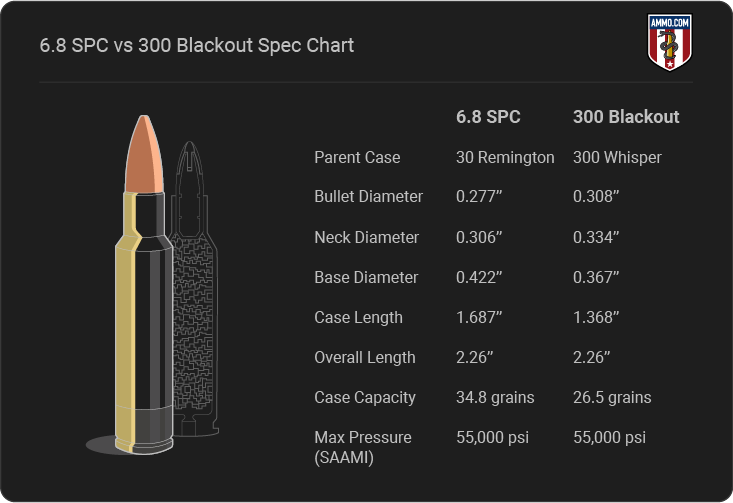
One thing to note about the 300 Blackout is that it uses the same bolt as a 5.56 NATO AR-15 carbine, while the 6.8 SPC requires a new bolt for caliber conversion. Both rounds require a barrel change, but in terms of ease of conversion, the 300 Blackout requires less specialized parts.
The drastic difference in case width also translates into the 6.8 SPC having a higher case capacity than the 300 BLK. The 6.8 SPC case can hold 34.8 grains of powder, while the capacity for the 300 Blackout is only 26.5 grains.
Although the 6.8 SPC can pack in a little over 8 grains more propellant, both cartridges have a max chamber pressure of 55,000 psi per SAAMI regulations.
Recoil
If you were thinking the 6.8 SPC has more free recoil due to its higher case capacity, you’d be correct.
Recoil is an important consideration when purchasing a new rifle, as a round with heavy recoil will be more difficult to control and will slow your rate of follow-up shots.
Recoil is affected primarily by muzzle velocity (FPS), powder charge, bullet weight, and rifle weight.
On average, the 6.8 SPC will have around 9 ft-lbs of free recoil compared to about 6 ft-lbs for the 300 Blackout. Although this means the 6.8 SPC has 50% more recoil than the 300 BLK, most shooters would categorize both rounds as being very soft shooting.
For comparison, the 308 Winchester typically has a free recoil of around 20 ft-lbs, so you can see that both the 6.8 and 300 Blackout are very easy on the shoulder.
However, if you’re recoil-sensitive or are training a new shooter, the 300 Blackout would be the better choice.
Trajectory, Muzzle Velocity, and Kinetic Energy
Before you make the commitment to a caliber conversion, it’s a good idea to compare the ballistics of each rifle cartridge and understand their capabilities.
For this example, we will compare the muzzle velocity (fps), muzzle energy (ft-lbs), and trajectory (bullet drop) for four different factory loads.
For the 300 Blackout, we will examine the Hornady Black 110-grain V-MAX and Federal American Eagle 150-grain FMJ. For the 6.8 SPC, we will consider the Hornady Black 110-grain V-MAX and the Prvi Partizan 115-grain FMJBT. The Hornady loads were selected to offer as close of an “apples to apples” comparison as possible.

The Hornady 110-grain bullets really tell the story here and showcase how the increased case capacity of the 6.8 SPC helps it pull away from the 300 Blackout.
At the muzzle for the Hornady loads, the 6.8 SPC has about 200 fps and 200 ft-lbs edge over the 300 Blackout. As the bullet travels downrange, the 6.8 SPC continues to pull away. At 500 yards, both 300 Blackout loads have gone subsonic (and their trajectory obviously suffers), while the 6.8 SPC is still supersonic at this range.
Overall, if you’re looking to shoot longer distances with these two cartridges, the 6.8 SPC is clearly the better choice, as it has a flatter trajectory and can maintain supersonic velocities longer.
Ballistic Coefficient and Sectional Density
Ballistic coefficient (BC) is a measure of how aerodynamic a bullet is and how well it will resist wind deflection. Sectional density (SD) is a way to evaluate the penetration ability of a bullet based on its external dimensions, design, and weight.
Typically, longer and heavier bullets will have a higher BC as they can resist wind drift more efficiently.
When comparing bullets of similar weight, like our two 110-grain V-MAX loads in the previous section, the 6.8 SPC will have a slight advantage in BC (0.370 vs 0.290) and SD (0.205 vs 0.166) as it fires longer, more slender bullets than the 300 Blackout.
However, the 300 AAC Blackout is also designed to fire heavier subsonic loads that outstrip the 6.8 SPC in both categories. For example, it is not uncommon for 200+ grain weight 30-caliber bullets to have a BC over 0.50 and SD over 0.30.
Therefore, when it comes to ballistic coefficient and sectional density for the 300 Blackout and 6.8 SPC, we have a rather mixed bag of results that are incredibly load and bullet-design dependent.
Accuracy
Accuracy is extremely difficult to quantify when comparing two different rifle cartridges since accuracy is more a byproduct of the firearm being used and the shooter pulling the trigger.
Generally, most shooters prefer a round with lower recoil as the likelihood of developing a trigger flinch is lower. Furthermore, low recoil allows for faster follow-up shots, making it easier to get multiple rounds on target quickly. This would suggest that the 300 Blackout is easier for shooters to be accurate with.
However, the 6.8 SPC has a flatter trajectory, making it a more forgiving cartridge for long-range shots.
Although both rounds are incredibly accurate, the 300 BLK will likely be easier to be accurate in close-quarters battle (CQB), while the 6.8 SPC will be better for long-range shots.
Hunting
Both the 300 Blackout and 6.8 SPC are exceptional hunting rounds, even if they weren’t initially designed for this purpose. However, the 6.8 SPC gives hunters a bit of an edge with a longer effective range and higher muzzle energy for larger game like whitetail or feral hogs.
Although the 6.8 SPC offers several ballistic advantages over the 300 Blackout, the 300 should not be marginalized as a hunting caliber, especially if you hunt in heavily wooded areas. Within 150 yards, the 300 Blackout will have no problem dropping a whitetail deer or a hog where it stands (with proper shot placement, of course). In this way, the 300 Blackout is similar to the heavier thumper rounds like the 450 Bushmaster, 458 SOCOM, and 50 Beowulf, except the 300 Blackout has considerably less recoil.
But if you plan on taking a longer range shot upwards of 250 to 300 yards, the 6.8 SPC is clearly the better choice as it has the energy to ethically harvest a deer at those ranges.
For varmints, the 300 Blackout offers shooters a low recoil option that works well for groundhogs, raccoons, and coyotes. The 6.8 SPC can also do the job but at the cost of slightly higher recoil.
Which is Better for Deer Hunting?
For deer hunting, both rounds can get the job done with proper bullet selection. Given that the 300 Blackout fires a 30-caliber projectile, there are a lot of options when it comes to hunting bullets, given the success of larger cartridges like the 308 Winchester, 300 Win Mag, and 30-06 Springfield.
The 6.8mm bullet or 0.277” caliber is not new to deer hunting, though, as the 270 Winchester is an extremely popular caliber for whitetail.
Determining which cartridge is best for deer hunting really depends on your local area and the range at which you expect to shoot a deer. If you hunt in a densely forested area like I do in the Midwest, then a 300 BLK is more than sufficient with a 150-yard effective range. However, if you plan on taking longer shots between 150 and 250 yards, then the 6.8 SPC is the better choice.
Suppressor Integration
Although the 6.8 SPC seems to be running away with this comparison, tap the brakes because the 300 ACC Blackout is perfect for use with a suppressor.
One of the key design features of the 300 BLK is that it experiences a complete powder burn in only 9 inches of barrel length. This means it is a perfect candidate for a short-barrel rifle (SBR).
Furthermore, 300 Blackout ammo comes loaded in either supersonic or subsonic velocities. And the upside to using subsonic ammo is that it’s hearing-safe when used with a suppressor.
Although there’s no downside to using a suppressor with a 6.8 SPC, there currently are only supersonic ammo offerings for the cartridge.
Self-Defense/Home Defense
Another category where the 300 Blackout really shines is home defense or self-defense scenarios.
One thing that many shooters often forget is how sound bounces off walls, making a rifle report sound even louder indoors. As it plays extremely well with a suppressor, the 300 Blackout makes a great choice for home defense as it has multiple subsonic ammo options.
As these rounds are hearing safe with a suppressor and the heavier bullet weight of these subsonic rounds have impressive terminal ballistics, they offer homeowners an option that has less chance to over-penetrate but can easily stop any home invader.
The lower recoil of the 300 BLK makes it a better choice for close-quarters engagements, as you’ll be able to get back on target faster for follow-up shots.
This is not to say that the 6.8 SPC is ineffective at self-defense because it certainly is a potent round. However, given the increased muzzle velocity, there is a higher likelihood for over-penetration, which presents a potentially dangerous scenario where your bullet inadvertently strikes an innocent bystander, neighbor, or family member.
Combined with a shorter barrel and a suppressor, a 300 Blackout AR-15 carbine can make for an extremely lightweight, maneuverable home defense option that has plenty of stopping power to defend your castle.
Ammo and Rifle Cost/Availability
If a 300 Blackout or 6.8 SPC caliber conversion, dedicated upper receiver, or rifle is in your acquisition plan for the near future, it’s important to know the availability of parts and ammo.
Considering that any standard AR-15 can easily be converted to shoot either cartridge with a quick upper receiver swap means that you won’t run out of host rifles anytime soon. However, if you live in a state or territory that requires hunting with a bolt-action rifle, then the 300 Blackout is your only option at the time of writing.
In terms of parts availability, the 300 Blackout simply has more, as it is the most successful caliber adapted to the AR-15. Numerous companies manufacture barrels or dedicated upper receivers, and since the 300 BLK uses the same bolt as the 5.56 NATO, you have a ton of options. On the other hand, the Remington SPC is a little more niche, and there are fewer options available for barrels, bolts, and uppers.
The 300 BLK also dominates in terms of ammo availability and price, as cheap plinking ammo can be had for around $0.70/round, while more expensive hunting ammo from companies like Barnes and Nosler can be had for around $2/round at the time of writing. For those looking to stock up, 300 Blackout bulk ammo options are widely available on our website, offering a cost-effective solution.
On the other hand, the cheapest 6.8 SPC starts around $1.10/round and goes up from there. Also, there are fewer manufacturers who are currently making 6.8 SPC ammo, whereas virtually every ammo manufacturer has at least one offering in 300 BLK, most of which offer both subsonic and supersonic ammo.
Reloading
If you enjoy making your own handloads as I do, then you’ll have a good time with either of these cartridges, as there are numerous reloading recipes, powders, and bullets to choose from.
However, the 300 Blackout has a bit of an edge over the 6.8 SPC in terms of brass availability because an experienced handloader can relatively easily convert 223 Remington cases into 300 Blackout cases.
On the other hand, you’ll need to either save your once-fired 6.8 SPC cases or buy some from a local range or online, as I’m guessing most handloaders don’t have a ton of 30 Remington brass lying around!
As far as bullet availability is concerned, the .308” caliber is about as American as apple pie. We simply love our 30-cals, and there are tons of bullets available in numerous configurations thanks to the success of the 30-06 Springfield, 308 Winchester, and 300 Win Mag.
The 0.277” caliber (6.8mm) is still popular thanks to the 270 Winchester and the new 277 Sig Fury, but bullets will not be as plentiful or inexpensive as 30-caliber bullets.
6.8 SPC vs 300 Blackout Ballistics
Below, you’ll find our ballistics tables for multiple factory loads for 300 AAC Blackout and Remington 6.8 SPC. This data is for reference only, and actual ballistic performance can vary depending on barrel length, load, and other shooting conditions.
6.8 SPC Ballistics
Note: This information comes from the manufacturer and is for informational purposes only. The actual ballistics obtained with your firearm can vary considerably from the advertised ballistics. Also, ballistics can vary from lot to lot with the same brand and type load.
| 6.8 SPC Bullet WEIGHT | Muzzle VELOCITY (fps) | Muzzle ENERGY (ft. lbs.) | TRAJECTORY (in.) | |||||||||||
|---|---|---|---|---|---|---|---|---|---|---|---|---|---|---|
| Muzzle | 100 yds. | 200 yds. | 300 yds. | 400 yds. | Muzzle | 100 yds. | 200 yds. | 300 yds. | 400 yds. | 100 yds. | 200 yds. | 300 yds. | 400 yds. | |
| 90 Grain | 2840 | 2444 | 2083 | 1756 | 1469 | 1611 | 1194 | 867 | 616 | 431 | 2.2 | 0 | -3.9 | -32 |
| 110 Grain | 2570 | 2338 | 2118 | 1910 | 1716 | 1613 | 1335 | 1095 | 891 | 719 | 2.4 | 0 | -6.3 | -20.8 |
| 115 Grain | 2775 | 2472 | 2190 | 1926 | 1683 | 1966 | 1561 | 1224 | 947 | 723 | 2.1 | 0 | -3.7 | -9.4 |
| 120 Grain | 2460 | 2250 | 2051 | 1863 | 1687 | 1612 | 1349 | 1121 | 925 | 758 | 2.3 | 0 | -10.5 | -31.1 |
300 Blackout Ballistics
Note: This information comes from the manufacturer and is for informational purposes only. The actual ballistics obtained with your firearm can vary considerably from the advertised ballistics. Also, ballistics can vary from lot to lot with the same brand and type load.
| 300 Blackout Bullet WEIGHT | Muzzle VELOCITY (fps) | Muzzle ENERGY (ft. lbs.) | TRAJECTORY (in.) | |||||||||||
|---|---|---|---|---|---|---|---|---|---|---|---|---|---|---|
| Muzzle | 100 yds. | 200 yds. | 300 yds. | 400 yds. | Muzzle | 100 yds. | 200 yds. | 300 yds. | 400 yds. | 100 yds. | 200 yds. | 300 yds. | 400 yds. | |
| 110 Grain | 2150 | 1886 | 1646 | 1432 | 1254 | 1128 | 869 | 661 | 501 | 384 | 0 | -8.3 | -29.6 | -67.8 |
| 125 Grain | 2250 | 2031 | 1826 | 1636 | 1464 | 1404 | 1145 | 926 | 743 | 595 | 0 | -7 | -24.4 | -54.8 |
| 220 Grain | 1000 | 968 | n/a | n/a | n/a | 488 | 457 | n/a | n/a | n/a | 0 | n/a | n/a | n/a |
300 Blackout Development/History
The development of the 300 AAC Blackout (designated 300 BLK by SAAMI) rifle cartridge began in 2010 when Robert Silvers of the Advanced Armament Corporation (which was later acquired by Remington) was approached by a member of the US Military “dark ops” community.
They wanted a round that was ideal for close-range engagements that would fit in standard STANAG standard AR-pattern mags, maintained 30-round capacity, mimicked the terminal ballistics of the 7.62x39, and didn’t require changing the gas system or bolt.
Integrating new calibers into the AR-15 platform is nothing new to the American shooting community. The 6.8 Remington Special Purpose Cartridge (SPC) and 6.5 Grendel are two examples that were mildly successful; however, they both required a new bolt and did not maintain the 30-round capacity requirement.
A new cartridge had to be developed, and the 300 Whisper, pioneered by JD Jones, was selected as the parent case. The 300 Whisper was a wildcat cartridge and, therefore, could not simply be adopted for military use as it was not SAAMI standardized.
The new round was called the 300 AAC Blackout (300 BLK or 300 Blackout) and was approved by SAAMI on January 17, 2011.
The 300 BLK was designed specifically to experience a full powder burn when being fired through a 9-inch barrel and functions perfectly with or without a suppressor/silencer.
To read more about the 300 Blackout, check out the full history of the cartridge on our 300 Blackout history page.
6.8 SPC Development/History
The 6.8 Remington Special Purpose Cartridge (6.8 SPC, 6.8 SPC II, or 6.8x43mm) was developed in 2004 as a joint operation between Remington Arms, US Special Operations Command (SOCOM), and the U.S. Army Marksmanship unit.
The goal of the cartridge was to increase the terminal performance of the M4 carbine, as urban close-quarters battle (CQB) in the 2nd Iraq War had showcased some deficiencies in the 5.56x45mm NATO/223 Remington cartridge.
Initial designs for the 6.8 SPC came from Master Sgt. Steve Holland and Chris Murray used the 30 Remington as a parent case that was modified to fit in standard M4 mags. However, as the Remington SPC case is wider than a 5.56 NATO case, a standard M4 mag will fit about 25 rounds of 6.8 SPC.
One key design point was that the 6.8 SPC was developed to perform better in short barrel rifles (SBR) like the M4 carbine, as opposed to the longer M16 assault rifle.
Fired from an M4, the 6.8 SPC can deliver almost 45% more kinetic energy into its target than standard 62-gr M855 NATO ammunition.
Although the 6.8 SPC seemed to be a potent answer to the 5.56 NATO terminal performance issue, there were some problems with its implementation, which we will discuss in the next section.
To read more about the 6.8 Remington SPC, check out the full history of the cartridge on our 6.8 SPC history page.
What’s the Difference Between Remington 6.8 SPC and SPC II?
Although the 6.8 SPC seemed to be a potent and elegant answer to the 5.56 NATO terminal performance issue, there were some problems with its implementation.
When you’re looking to purchase a new upper receiver or barrel for 6.8, you might notice that the barrel is stamped as 6.8 SPC II. Many new shooters wonder what the difference between 6.8 SPC and 6.8 SPC II is, and the answer is in the design of the chamber.
The 6.8 SPC II chamber is designed to handle full-power 6.8mm SPC loads, while the original 6.8 SPC chamber had a design flaw that could potentially cause pressure issues.
In their haste to bring the 6.8 SPC to market and capitalize on the hype surrounding the new round, Remington botched the release of the cartridge with inaccurate chamber design specifications.
The original chamber designs called for 0.050” of free bore. However, when combined with a 1:10 twist rate barrel, pressure issues began to creep up. Initial reports claimed that the rounds were only around 200 psi above the maximum 55,000 psi pressure limits, but if the military learned anything from Vietnam, it was to follow specs to the letter.
Remington sought to remedy the higher pressure issue the best way they saw fit, which was to underload the ammo instead of fixing the free bore measurement. The resulting “light” 6.8 SPC ammo failed to meet expectations, and the US Army scrapped the project.
However, in all the excitement over the new 6.8 SPC, several civilian firearm manufacturers clambered to release rifles chambered in the new cartridge before SAAMI had officially standardized the 6.8 SPC round. With numerous faulty rifles in circulation, the only action SAAMI could take was to sanction the round.
This is not to say that original 6.8 SPC rifles won’t function properly, but there is the potential for a critical pressure failure when using full-power rounds.
The answer was the 6.8 SPC II.
The 6.8 SPC II added an additional 0.050” of free bore to the chamber and decreased the barrel twist rate to 1:11. This completely resolved the pressure issues experienced with the original design. All current rifles chambered in 6.8 SPC are technically chambered in 6.8 SPC II.
Although most factory loads will be loaded light (due to potential liability issues of original 6.8 SPC rifles still running loose in the wild), ammo for 6.8 SPC II rifles can be loaded to the full potential that the round was designed for.
Parting Shots: 300 BLK vs 6.8 SPC
The 300 AAC Blackout and 6.8 Remington SPC are two hard-hitting cartridges that offer increased stopping power to the AR platform. Not only are they both excellent rifle cartridges for close-range engagements, but are both capable hunting rounds that harvest countless whitetail deer and feral hogs every year.
The 300 BLK has considerably less recoil than the 6.8 SPC and is movie-quiet when firing subsonic ammo through a suppressor. The 6.8 SPC offers shooters a longer effective range and improved external ballistics over 300 BLK.
If you’re looking for a home defense carbine or SBR, it’s hard to beat the 300 Blackout. But if you need a longer effective range and don’t care about shooting subsonic ammo, then the 6.8 SPC is an awesome choice.
No matter which rifle cartridge you choose for your next AR-15, make sure to get all your ammunition here at Ammo.com, and we’ll see you out on the range!
Ammo Comparisons
- .308 vs 5.56
- 6.5 Creedmoor vs .308
- .300 Blackout vs .308
- .300 Win Mag vs .308
- .243 vs .308
- .308 vs .30-06
- 7mm-08 vs .308
- .270 vs .308
- 7.62x39 vs .308
- .223 vs .308
- .338 Lapua vs .308
- .380 ACP vs 9mm
- .223 vs 5.56
- .300 Blackout vs 5.56
- 9mm vs 45 ACP
- 9mm vs 40 S&W
- .357 SIG vs 9mm
- 10mm vs 9mm
- 9mm vs 9mm Luger
- .243 vs .270
- .300 Win Mag vs .30-06
- .270 vs .30-06
- .40 vs .45
- 38 Special vs 357
- 9mm vs 40 vs 45
- 5.56 vs 7.62x39
- 338 Lapua vs .30-06
- .30-30 vs .30-06
- 300 PRC vs 338 Lapua
- .30-06 vs 7mm
- 300 Win Mag vs 338 Lapua
- 300 PRC vs 300 Win Mag
- 300 WSM vs 300 Win Mag
- 338 Win Mag vs 338 Lapua
- 12 Gauge vs 20 Gauge
- 10mm vs 357 Mag
- .30-30 vs 7.62x39
- 224 Valkyrie vs 22-250
- 17 HMR vs 22 Mag
- 7.62x39 vs .300 Blackout
- 45 ACP vs 45 Auto
- 45-70 vs 30-30
- 300 Blackout vs 223
- 357 Magnum vs 9mm
- 350 Legend vs 300 Blackout
- 224 Valkyrie vs 223
- 45 ACP vs 38 Super
- 6.5 Grendel vs .308
- 17 HMR vs 22 LR
- 10 Gauge vs 12 Gauge
- 22-250 vs 223
- 45 Colt vs 45 ACP
- 350 Legend vs 30-30
- 5.7x28 vs 223
- 5.7 vs 9mm
- 5.56 vs 5.7
- 22 vs 9mm
- Buckshot vs Birdshot
- 450 Bushmaster vs 308
- 450 Bushmaster vs 223
- Buckshot vs Slug
- 6.5 Grendel vs 5.56 vs 223
- 6mm ARC vs 6.5 Grendel
- 44 vs 45
- 458 SOCOM vs 5.56
- 357 vs 44
- 32 ACP vs 380
- 300 Win Mag vs 338 Win Mag vs 338 Lapua Mag
- 450 Bushmaster vs 458 SOCOM vs 50 Beowulf
- 6mm Creedmoor vs 6.5 Creedmoor
- TMJ vs FMJ
- 44 Special Vs 44 Magnum
- 45 90 vs 45 70
- 6.8 Western vs 6.8 SPC
- 50 Beowulf vs 50 BMG
- 26 Nosler vs 6.5 PRC
- 28 Gauge vs 410
- 6.8 SPC vs 5.56
- 6.8 SPC vs 6.5 Grendel
- 6.8 Western vs 7mm Rem Mag vs .28 Nosler
- 6.8 Western vs 6.5 Creedmoor
- 22 Hornet vs 223
- 6.8 Western vs 6.5 PRC
- .410 vs 12 Gauge
- .410 vs 20 Gauge
- 22 LR vs 22 Mag
- 6mm ARC vs 243
- 7mm-08 vs 270
- 243 vs 6.5 Creedmoor
- Nickel vs Brass Casing
- 204 Ruger vs 223
- 50 Beowulf vs 5.56
- 260 Remington vs 6.5 Creedmoor
- 6mm Remington vs 243
- 28 Nosler vs 300 PRC
- 50 Beowulf vs 50 AE
- 22 Nosler vs 22-250
- 450 Marlin vs 45-70
- 300 Win Mag vs 300 Norma
- 458 SOCOM vs 300 Blackout
- 38-55 vs 45-70
- 22 Hornet vs 22 LR
- 300 Norma vs 338 Lapua
- 338 Lapua vs 50 BMG
- 28 Nosler vs 300 Win Mag
- 28 Nosler vs 6.5 Creedmoor
- 204 vs 22-250
- 458 SOCOM vs 45 70
- 44 40 vs 45 70
- 6.8 SPC vs 6.5 Creedmoor
- 450 Bushmaster vs 30-06
- 7mm Rem Mag vs 300 Win Mag
- 30 Carbine vs 223
- 25-06 vs 30-06
- 26 Nosler vs 28 Nosler
- 16ga vs 12ga
- 30 06 vs 7.62 x54R
- 9mm Makarov vs 9mm Luger
- 350 Legend vs 223
- 30 Carbine vs 5.56
- 6.5x55 vs 6.5 Creedmoor
- 6.5 Creedmoor vs 270 vs 25-06
- M193 vs M855
- 450 Bushmaster vs 458 SOCOM
- 6.5 Grendel vs 6.5 Creedmoor
- 350 Legend vs 5.56
- .277 Fury vs 6.8 SPC
- 277 Fury vs 300 Win Mag
- 10mm vs .45 ACP
- 277 Fury vs 223
- 6.8 SPC vs 300 Blackout
- 6.5 PRC vs 6.5 Creedmoor
- 277 Fury vs 308
- 277 Fury vs 6.5 Creedmoor
- 350 Legend vs 450 Bushmaster
- 277 Fury Vs 5.56 NATO
- 10mm vs 40S&W
- 32 ACP vs 9mm
- 32 Special vs 9mm
- 8.6 Blackout vs 300 Blackout
- 30 Super Carry vs. 9mm
- 5.56 vs 9mm
- .50 Action Express vs 9mm
- 7.62x25 vs. 9mm
- 10mm vs 44 Magnum
- 300 Blackout vs 300 Win Mag
- 6.5 Grendel vs 300 Blackout
- 460 Rowland vs 10mm
- 300 RUM vs 300 PRC
- 300 Norma vs 300 PRC
- 45 GAP vs 45 ACP
- 7mm PRC vs 300 Win Mag
- 300 PRC vs 6.5 Creedmoor
- 300 PRC vs 308
- 357 SIG vs 357 Mag
- 7.62x39 vs 7.62x51
- 243 Win vs 223 Rem
- 30 Nosler vs 300 PRC
- 6.5 Creedmoor vs. 30-06 Springfield
- 450 S&W vs. 44 Magnum
- 6.5 Creedmoor vs. 300 Win Mag
- 454 Cassull vs. 45-70 Govt
- 454 Cassull vs. 44 Mag
- 7.62x54r vs. 308 Winchester
- 22 ARC vs. 223 Rem
- Subsonic vs. Supersonic Ammo

